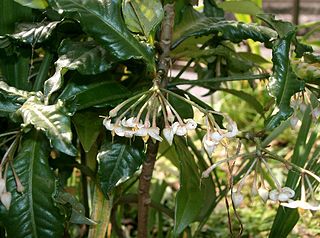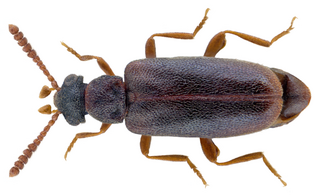
The sap beetles, also known as Nitidulidae, are a family of beetles.

Ardisia is a genus of flowering plants in the family Primulaceae. It was in the former Myrsinaceae family now recognised as the myrsine sub-family Myrsinoideae. They are distributed in the Americas, Asia, Australia, and the Pacific Islands, mainly in the tropics. There are over 700 accepted species. One species, Ardisia japonica is one of the 50 fundamental herbs in traditional Chinese medicine.

Amanita brunnescens, also known as the brown American star-footed amanita or cleft-footed amanita is a native North American mushroom of the large genus Amanita. Originally presumed to be the highly toxic Amanita phalloides by renowned American mycologist Charles Horton Peck, it was described and named by George F. Atkinson of Cornell University. He named it after the fact that it bruised brown. It differs from the death cap by its fragile volva and tendency to bruise brown. It is considered probably poisonous.

The pectoral-patch cisticola is a species of bird in the family Cisticolidae. It is found in Cameroon, Republic of the Congo, Democratic Republic of the Congo, Eritrea, Ethiopia, Gabon, Kenya, Somalia and Tanzania. Its natural habitats are damp or wet areas in upland grassland.
Scoliosia is a monotypic moth genus in the subfamily Arctiinae erected by George Hampson in 1914. Its single species, Scoliosia brunnescens, was first described by Walter Rothschild in 1912. It is found in Papua and Papua New Guinea.

Amanita aestivalis, commonly known as the white American star-footed amanita, is a species of fungus in the mushroom family Amanitaceae. The fungus is distributed in the eastern United States, south to Florida, and reaches north into the southeastern provinces of Canada. The cap of the fruit body is medium-sized, 5 to 8.5 cm in diameter and white. It sits atop a stem that is 8.5 to 16 cm long and has a rounded bulb at its base. The entire fruit body will slowly stain a reddish-brown color in response to bruising or aging. It remains unknown whether Amanita aestivalis is a distinct species from A. brunnescens, another similar Amanita with a comparable distribution. There are several other white-bodied amanitas with which A. aestivalis may be confused, including A. virosa, A. phalloides, and A. bisporigera.

Hume's bush warbler is a species of bush warbler. It was formerly included in the "Old World warbler" assemblage.
Rio Abajo Forest is a forested preserve in Puerto Rico owned by the Department of Natural Resources. It was designated a National Natural Landmark in 1980 and constitutes an area of 3,590 acres. It consists mostly of subtropical wet and moist karst forest. Mogotes and sinkholes fill the landscape.

The Puerto Rican broad-winged hawk is an endangered subspecies of the broad-winged hawk. It is a small hawk that occurs in Puerto Rico, inhabiting the Toro Negro State Forest. Its Spanish common name is guaragüao de bosque.

Carex brunnescens, the brownish sedge or green bog sedge, is a species of plant in the sedge family (Cyperaceae). It has a circumboreal distribution, and is native to North America and Eurasia. In the United States it is primarily found in the Northeast and Midwest extending south into the Appalachian Mountains, with disjunct populations westward in the Rocky Mountains. It has a wide-ranging natural habitat, is in found in forests, bogs, fens, and rock outcrops.
Stenocerus is a genus of fungus weevils in the beetle family Anthribidae. There are more than 20 described species in Stenocerus.

Lobiopa is a genus of sap-feeding beetles in the family Nitidulidae. There are about seven described species in Lobiopa.

Lobiopa undulata is a species of sap-feeding beetle in the family Nitidulidae. It is found in North America.
Lobiopa falli is a species of sap-feeding beetle in the family Nitidulidae. It is found in North America.
Lobiopa insularis is a species of sap-feeding beetle in the family Nitidulidae. It is found in the Caribbean Sea, Central America, North America, and South America.

Vanonus is a genus of ant-like leaf beetles in the family Aderidae. There are about 16 described species in Vanonus.
Xestolabus is a genus of leaf-rolling weevils in the beetle family Attelabidae. There are at least 30 described species in Xestolabus.
Dubiraphia brunnescens, the brownish dubiraphian riffle beetle, is a species of riffle beetle in the family Elmidae. It is found in North America.
Hyperaspis brunnescens is a species of lady beetle in the family Coccinellidae. It is found in North America.
Chaetocnema brunnescens, the buttonwood flea beetle, is a species of flea beetle in the family Chrysomelidae. It is found in the Caribbean Sea and North America.









